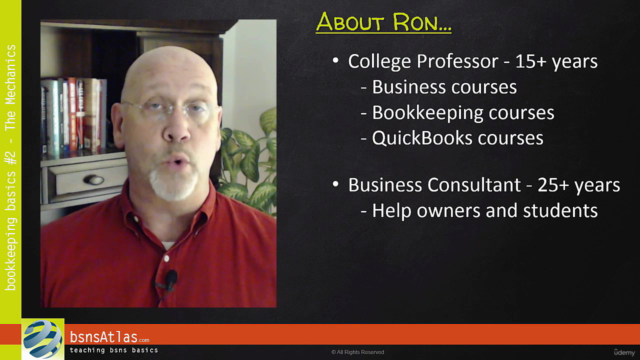Bookkeeping Basics #2: Understand The Mechanics

Why take this course?
📚 Bookkeeping Basics #2: Understand The Mechanics 💰
🚀 Course Headline: After mastering the basics in our first course, it's time to dive deeper into the "How" of recording bookkeeping activities. Join Ron Truck for a hands-on journey through the essentials of debits and credits in this comprehensive course designed to demystify the mechanics of bookkeeping.
🌍 Course Description:
Welcome to a world where bookkeeping transforms from a daunting task into a clear, manageable process. In this focused course, Ron Truck guides you through a series of easy-to-follow video lessons enhanced with simple explanations, engaging illustrations, and comprehensive note sheets. These tools are specifically crafted to help you grasp the foundational concepts of bookkeeping.
🎓 What You'll Learn:
- ✅ Debits vs. Credits: Understand the core difference between these two fundamental elements in bookkeeping and how they impact your financial health.
- ✅ Assets, Liabilities & Equity: See how debits and credits are integral to managing your company's assets, liabilities, and equity.
- ✅ Income & Expenses: Learn the relationship between debits/credits and your business's income and expenses.
- ✅ T-Account Mastery: Get acquainted with the T-Account, a crucial tool for recording bookkeeping transactions accurately.
- ✅ Memorization Technique: Discover an EASY technique to remember when to use "debit" versus "credit."
📚 Course Components & Tools:
This course is designed to complement other courses in the series, including:
- A primer on the basic fundamentals of bookkeeping for small businesses.
- A complete practice set to apply your new knowledge in real-world scenarios.
- An overview of the largest small business software in the world.
- A course that connects bookkeeping concepts with personal finance.
🏆 CPE & Learning Objectives:
Upon completion, you will:
- Understand the main components of the Fundamental Accounting Equation.
- Distinguish between accounts that increase as debits versus credits.
- Discuss the process of footing and balancing T-accounts/ledgers.
- Explain the steps in the Accounting Cycle.
- Define the difference between Interim and Final financial reports.
- Recognize the need for Adjusting and Closing activities within the Accounting Cycle.
- Demonstrate how to record adjusting entries, including depreciation, accrued liabilities, inventory tracking, and prepaid assets.
- Understand why annual bookkeeping records are closed each year.
- List the types of accounts that are closed versus those that remain open during the closing process.
📖 Additional Information & Support:
For more details on our policies, including CPE accreditation and course refunds, or for support-related queries, please refer to the Udemy Terms of Use or reach out through the Help and Support link below. Our team is committed to ensuring your learning experience is both educational and enjoyable.
🎉 Ready to Master Bookkeeping? Enroll in "Bookkeeping Basics #2: Understand The Mechanics" today and take the first step towards financial confidence and proficiency! 💼✨
Course Gallery




Loading charts...
Comidoc Review
Our Verdict
Boasting a solid 4.69 rating and over 10,000 subscribers, the 'Bookkeeping Basics #2: Understand The Mechanics' course offers a deep dive into the practical aspects of bookkeeping. Students will benefit from focused lessons on journaling, debits, credits, and adjustment entries. However, be prepared for occasional challenges with confusing homework assignments and a need for more detailed quiz explanations. With practice sets available online and improved print design, this course aims to equip learners confidently navigating the world of bookkeeping basics.
What We Liked
- Comprehensive coverage of bookkeeping mechanics, including debits, credits, journaling and adjustment entries
- In-depth approach to the Fundamental Accounting Equation
- Step-by-step instruction on end-of-month and end-of-year closing entries
- Realistic practice sets provided for homework assignments
Potential Drawbacks
- Homework assignments can sometimes be difficult to understand, with missing pages or unclear instructions
- Lack of detailed explanations for why certain quiz answers are correct
- Presentation design could benefit from improved readability when printing resources
- Some lessons rely solely on homework without sufficient review or discussion